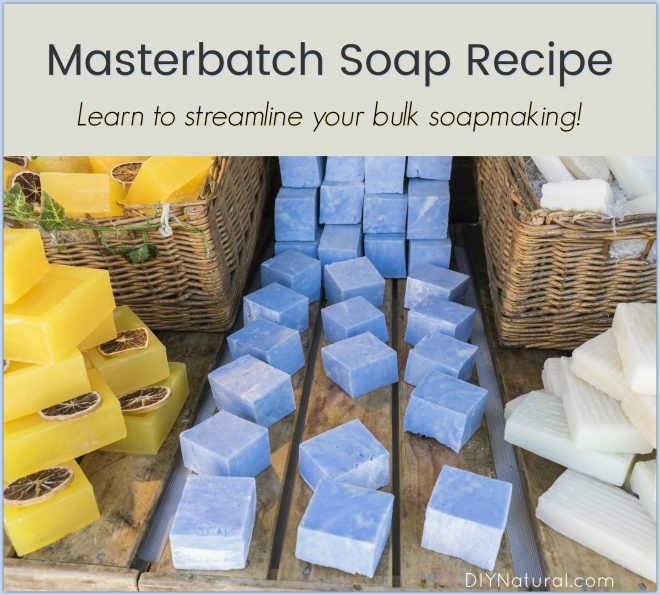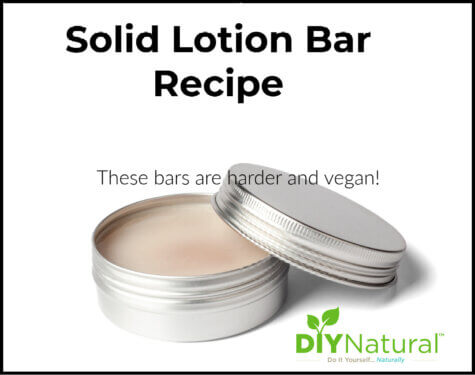
By now, most of you know I’m a soap maker. I get small orders all the time, and I have one large standing order of 200 bars just about every month. Using the masterbatch process, I can make 100+ bars of soap in one weekend!
What is Masterbatch?
Masterbatch is an easy way to speed up your soap making, or just about any other craft project process. I’m using soap making as an example, but you can apply it to other crafts such as cooking or dyeing fabric. It takes a bit of math, but nothing too complicated.
Using The Masterbatch Process
I have a basic soap recipe that makes about 5 bars of soap, 4 ounces each. This is enough for personal use, but when I’m filling my large order each month I use the masterbatch process. Let’s take a look at my basic recipe:
- 4.75 ounces olive oil
- 4.75 ounces coconut oil
- and 4.75 ounces vegetable oil blend (I use rice bran oil, avocado oil, shea butter, and palm kernel oil)
- 2.5 ounces lye beads
- 5.75 ounces distilled water
If you want the entire recipe with instructions, you can find it here.
To masterbatch this recipe I need to multiply it by 20. I’ll have a bit left over, but I’ll use that to make some sample bars or experiment with a new scent or color.
Doing some quick math yields a new masterbatch recipe.
Masterbatch Soap Recipe
Ingredients
- 95 ounces olive oil
- 95 ounces coconut oil (find it here)
- and 95 ounces vegetable oil blend (I use rice bran oil, avocado oil, shea butter, and palm kernel oil)
- 50 ounces lye beads (find them here)
- 115 ounces distilled water
Process for the Oils
- Using a very large pot (I use a stainless steel stock pot), melt each oil on low heat before weighing to be sure the oils will all blend together well. This is important since you’ll be dividing it back out later.
- Weigh your melted oils. Add the correct amount of each to a large bucket with a lid. (Hardware stores usually carry 5 gallon buckets with lids, or find one here.) Be sure it is absolutely clean and dry before using it or you may invite bacteria or mold.
- Once you get all the oils in the bucket, stir well. There may be some settling of denser oil as it cools, but if it is blended well this shouldn’t happen.
- Place lid securely on bucket, and store in a safe place where it will be undisturbed.
Process for the Lye
- Weigh all the water into a large container. Weigh your lye and mix in. I use a stock pot for this because this large amount of lye can create a lot of heat for a glass container. It can still get to 200°F, so be sure your container can handle the heat. I would also place the container in a plastic dish pan or something, just in case there is some breakage. It’s rare, but it can happen.
- Allow your lye mixture to cool and store in a container that will not be affected by the lye. A drink pitcher is the best idea since lye can break glass but rarely affects plastic.
- Be sure to label it very well, and store in a safe place away from children or pets. You don’t want someone coming in contact with it thinking it’s water. Everyone in my household knows not to go near anything in the soap room as it can potentially be something other than it appears. Store it up off the floor or in a locked closet if you have small children or pets.
Using the Masterbatch
Now that all of your lye and oils are masterbatched, making soap will be a breeze.
I take the total volume, 285 ounces, and divide it by 4, which gives me 71.25 ounces. This is what I need for about 25 bars of soap. Then I do the same with the lye mixture, which gives me 165 ounces. Divide that by 4 and you get 41.25 ounces. Now you can weigh it out and make soap as you normally would.
Because your lye and oils will both be at room temperature when you start, you’ll probably need to heat the oils a bit. Normally you would want to bring the oils and lye mixture to within the same temperature range, about 95°-105°F is best. I’ve found over the years that the actual temperature of each doesn’t matter as long as they add up to what you wanted in the first place, so around 200°F in this case. If your room temperature is 75°F, then your oils need to be around 125°F to make it work. Soap can be made at lower temperatures, but it never blends correctly. And when made at higher temperatures, the soap tends to be grainy and coarse.
A Few Tips
Here are a few things about masterbatching that I’ve figured out along the way:
- Always be sure your measurements are correct. Nothing throws a batch of soap off faster than the wrong amounts of oil or lye.
- Wash out containers after each use. Lye can develop crystals or soda ash on the sides, making chunks or flakes that can fall off into your soap. Be sure to use a bit of vinegar (any kind) when you do the final rinse to be sure all of the lye is neutralized.
- Oils can go rancid over time. It’s better to clean your container well than to risk having a big batch of oil go rancid. Oil can also get gummy over time, and this is another thing you don’t want in your soap.
- Be sure to have molds ready before beginning. I’m lucky enough to have 11-12 cavity molds, so making 100 bars at a time is easy. But if you only have one or two and need to make a lot more, do what you can. Wait at least 24 hours, turn your soaps out, clean the molds, and make another batch. Because you’ve divided the batch by 4, you’ll get 25 or so each time.
Have you ever tried a masterbatch recipe? What did you think?
*******




How much each of rice bran oil, avocadooil, Shea butter, palm kernel oils?
Slippery elm bark has the ability to prevent oils from going rancid. Mix a bit of the powder into your oil, heat for a few minutes, strain it, then re-cool and store. It takes very little of the powder. A ratio of 1:100 is more than sufficient.